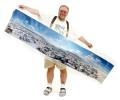Solving Selfish Merge, again
Submitted by brad on Tue, 2008-10-14 22:00I've written a few times about the "Selfish Merge" problem. Recently, reading the new book Traffic: Why We Drive the Way We Do by Tom Vanderbilt, I came upon some new research that has changed and refined my thinking.
The selfish merge problem occurs when two lanes reduce to one. Typically, most people try to be "good" and merge early, and that leaves the right lane, which is ending, mostly vacant. So some people zoom ahead of everybody in the right lane, and then merge at the very end. This is selfish in the sense that butting into any line is selfish. Even if overall traffic flow is not reduced (and even if it is increased) the person butting in moves everybody back one slot so they can get ahead by many slots. This angers people and generates more counter-productive behaviour, including road rage, and attempts to straddle the lanes so that the selfish mergers can't move up to the merge point.
In Traffic, Vanderbilt writes of surprising research that changed his mind, which showed that, in simulations, some merging forms provided up to 15% more traffic throughput than proper attempts at a zipper merge. In particular, a non-selfish merge fully using the vanishing lane worked better than the typical butt-in situation described at the top.
In this merge, which I'll call the "slow and fair merge," drivers are told to use both lanes up to the merge-point, and then to fairly "take their turn" at the merge point entering the continuing lane. Nobody is selfish here, in that nobody butts ahead of anybody else, but both lanes are fully utilized up to the merge point.
This problem is complex, I believe, because there is a switch-over point, which I call the "collapse" point. This is the point at which the merge flow becomes high enough that traffic collapses to "stop and go" mode, before and at the merge-point. Before that point, in lighter traffic, there is little doubt (for reasons you will see below) that the "cooperating fast zipper" merge results in the best traffic flow. In particular, there are traffic volumes where you could either have cooperating zipper or "slow and fair" but cooperating zipper would do a fair bit better. There are also traffic volumes where cooperating zipper just isn't possible any more, and we will either have "slow and fair" (which has the best volume) or "selfish merge" which has a worse volume.
Real world experiments show different results from the theoretical. In particular, many drivers, used to the anarchic selfish-merge approach, don't understand fair and slow, even when signs are explicit about it, and so they resist using both lanes and try to merge early. They also try to straddle, devolving to selfish merge. An experiment with digital signs which changed from advising drivers to zipper-merge in light traffic to advising "use both lanes" and "merge here, take your turn" in heavier traffic was disobeyed in fair and slow mode by too many drivers. The experiment ended before people could learn the system.



